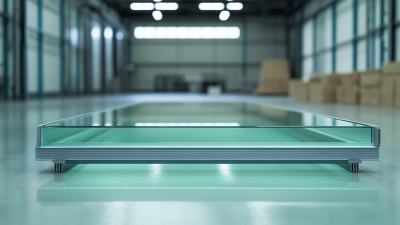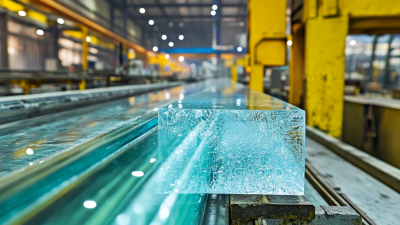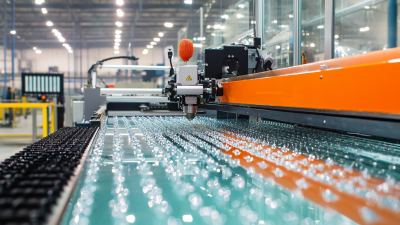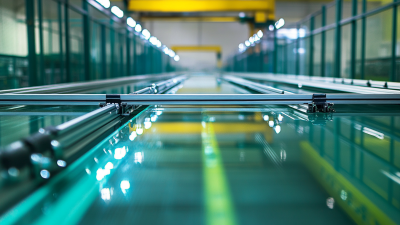Exploring Innovative Designs: Unique Applications of Glass Edging Processing Machines
In the rapidly evolving glass fabrication industry, the significance of advanced machinery cannot be overstated. Among these, the Glass Edging Processing Machine stands out as a crucial innovation that enhances both functionality and aesthetics in glass production. According to a recent report by MarketsandMarkets, the glass processing market is projected to grow from USD 5.56 billion in 2021 to USD 8.54 billion by 2026, signifying a compound annual growth rate (CAGR) of 9.0%. This surge is largely attributed to increasing demand for architectural glazing and the rising need for customized glass applications across various sectors, including automotive and furniture design. As manufacturers seek to differentiate their offerings, the capabilities of Glass Edging Processing Machines in delivering precise edges and unique finishes become increasingly valuable, paving the way for innovative designs that cater to a diverse range of customer needs.

Innovative Glass Edging Techniques: Transforming Design Possibilities
Innovative glass edging techniques have revolutionized the world of design, opening up a realm of possibilities that were previously unimaginable. With advancements in glass edging processing machines, designers are now able to create intricate shapes and finishes that enhance the aesthetic appeal of glass products. From sleek, modern furniture to eye-catching architectural elements, the precision offered by these machines allows for consistent quality and unique designs that elevate any project.
One exciting application of these innovative techniques is in the realm of custom glass installations. Designers are taking advantage of the ability to create custom edges, curves, and patterns that perfectly fit their vision. For instance, the use of polished edges can add a sophisticated touch to countertops and tabletops, while beveled edges can create a stunning visual effect in windows and partitions. The versatility of glass edging not only enhances visual appeal but also pushes the boundaries of creativity, enabling designers to experiment with different styles and finishes to truly transform their spaces.
Innovative Glass Edging Techniques - Data Overview
This chart illustrates the percentage of innovative applications for glass edging processing machines across various design sectors. The data showcases the growing trend of glass edging in architecture, automotive, and furniture design.
Exploring Different Types of Glass Edging Machines for Unique Applications
The glass edging machine industry has seen substantial advancements, catering to a multitude of unique applications across various sectors. According to a recent report by MarketsandMarkets, the global glass processing machinery market is expected to grow from $2.5 billion in 2021 to $3.8 billion by 2026, highlighting a promising demand for innovative designs and processing capabilities. These machines are now capable of creating intricate edges, bevels, and profiles, allowing glass manufacturers to meet the specific needs of designers and architects looking for distinctive aesthetics in their projects.

There are several types of glass edging machines available, each designed for specialized tasks. For instance, CNC glass edging machines offer precision and flexibility, ideal for producing customized glass products like shower enclosures and decorative glass panels. Additionally, the introduction of automated finishing machines has enhanced production efficiency, reducing labor costs while maintaining high-quality standards. The versatility of these machines, combined with advanced technologies such as robotics and IoT integration, allows manufacturers to push the boundaries of creativity and innovation, resulting in increasingly unique glass applications that appeal to both industrial and residential markets.
Creative Uses of Edged Glass in Modern Architecture and Interior Design
The application of edged glass in modern architecture and interior design continues to revolutionize how spaces are both perceived and utilized. According to a recent report by Transparency Market Research, the global market for architectural glass, including edged and processed varieties, is projected to reach USD 137.5 billion by 2027, showcasing a significant growth driven by innovative design concepts. Edged glass not only enhances aesthetic appeal but also emphasizes functional aspects such as durability and safety, making it an essential element in contemporary structures.
Moreover, edged glass is being creatively employed in various interior design scenarios, from bespoke cabinetry to striking wall dividers that allow for an interplay of light and space. A study by MarketsandMarkets indicated that the demand for decorative glass is expected to increase at a compound annual growth rate (CAGR) of 5.3% between 2021 and 2026. Designers are leveraging the unique qualities of glass edging processing to create intricate patterns and textures, resulting in stunning visual effects that transform ordinary spaces into extraordinary environments. As architects and interior designers continue to explore these innovative applications, edged glass is set to remain at the forefront of modern design trends.
Key Factors to Consider When Choosing a Glass Edging Processing Machine
When selecting a glass edging processing machine, there are several key factors that should guide your decision. First and foremost, the specific requirements of your projects will dictate the type of machine that best suits your needs. Different machines offer various capabilities, such as the range of glass thickness they can handle, the types of edges they can create, and their speed of operation. Understanding these specifications ensures that you invest in equipment that can maximize productivity and meet the demands of your projects.
Another critical factor to consider is the machine's precision and reliability. The edging process is crucial for achieving high-quality finishes, which can significantly impact the overall aesthetic of the final product. Look for machines equipped with advanced technology that can guarantee consistent performance and excellent edge quality. Additionally, the ease of use and maintenance of the machine should not be overlooked, as user-friendly interfaces and accessible service options can greatly enhance your workflow and minimize downtime. By prioritizing these considerations, you can choose a glass edging processing machine that supports your creative vision and operational goals.
Exploring Innovative Designs: Unique Applications of Glass Edging Processing Machines - Key Factors to Consider When Choosing a Glass Edging Processing Machine
| Feature |
Description |
Considerations |
| Type of Edging |
Straight, beveled, or polished edges for different applications. |
Choose based on the specific product requirements. |
| Machine Speed |
Process speed in meters per minute. |
Consider overall production capacity and efficiency. |
| Automation Level |
Manual, semi-automated, or fully automated options. |
Evaluate labor costs and desired output consistency. |
| Energy Efficiency |
Energy consumption per hour of operation. |
Assess the environmental impact and operating costs. |
| Size and Weight |
Dimensions and weight of the machine. |
Ensure it fits within the facility’s space constraints. |
| Maintenance Requirements |
Frequency and types of maintenance needed. |
Consider availability of spare parts and technician skills. |
Tips for Maximizing Efficiency and Quality in Glass Edging Projects
In the glass processing industry, maximizing efficiency and quality is crucial for staying competitive. According to a recent report by MarketsandMarkets, the global glass edging machine market is projected to grow from $350 million in 2021 to $490 million by 2026, reflecting a
compound annual growth rate (CAGR) of 6.7%. This growth underscores the importance of adopting cutting-edge technology and innovative designs in glass edging projects to streamline production processes and enhance product quality.
 When utilizing glass edging processing machines, it is essential to prioritize proper machine calibration and maintenance. Regular checks and adjustments can significantly reduce wastage and improve accuracy. According to a study by the Glass Association, maintaining optimal machine conditions can lead to a reduction in material costs by up to
15%, allowing businesses to reinvest savings into expanding their service offerings or upgrading their equipment. Furthermore, employing advanced software solutions for design and production management aids in achieving higher precision, ensuring that the beveled edges of glass pieces meet stringent quality standards while minimizing errors in the production line.
When utilizing glass edging processing machines, it is essential to prioritize proper machine calibration and maintenance. Regular checks and adjustments can significantly reduce wastage and improve accuracy. According to a study by the Glass Association, maintaining optimal machine conditions can lead to a reduction in material costs by up to
15%, allowing businesses to reinvest savings into expanding their service offerings or upgrading their equipment. Furthermore, employing advanced software solutions for design and production management aids in achieving higher precision, ensuring that the beveled edges of glass pieces meet stringent quality standards while minimizing errors in the production line.
In addition to technology, investing in skilled operators is vital for maximizing efficiency. A report from the Society of Glass Manufacturers indicates that companies with well-trained staff see a
25% increase in productive output compared to those with less experienced teams. By focusing on employee training and implementing best practices in glass edging, manufacturers can enhance both the quality of their products and their overall operational efficiency.

Home
About Us
Products
UPVC PVC Window Machine
Aluminum Window Machine
Glass Cutting Machine
Glass Edging Machine
Insulating Glass Machine
Glass lifting machine
Glass Washing Machine
Glass Laminating Machine
Glass Sandblasting Machine
Glass Drilling Machine
CNC Glass Working Center
CNC Non-Metal Cutting Machine
The Other Glass Machinery
Application
Download
News
Contact Us


 When utilizing glass edging processing machines, it is essential to prioritize proper machine calibration and maintenance. Regular checks and adjustments can significantly reduce wastage and improve accuracy. According to a study by the Glass Association, maintaining optimal machine conditions can lead to a reduction in material costs by up to
When utilizing glass edging processing machines, it is essential to prioritize proper machine calibration and maintenance. Regular checks and adjustments can significantly reduce wastage and improve accuracy. According to a study by the Glass Association, maintaining optimal machine conditions can lead to a reduction in material costs by up to





